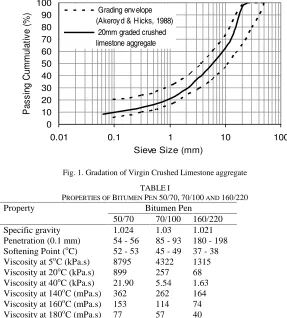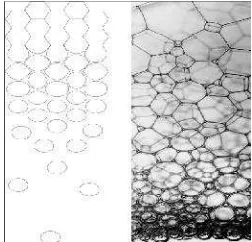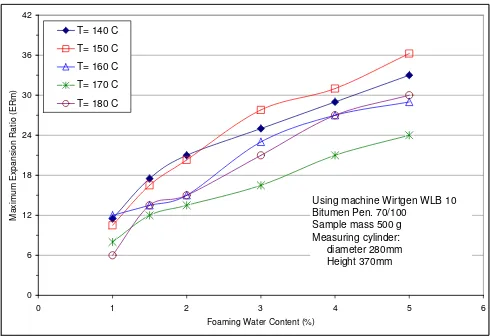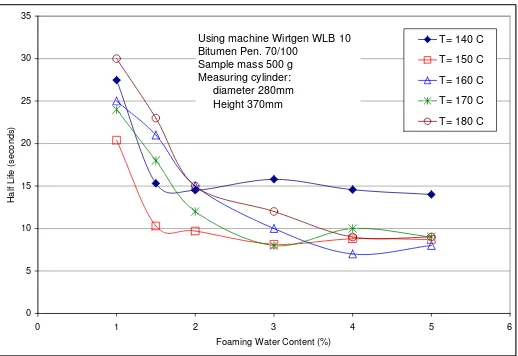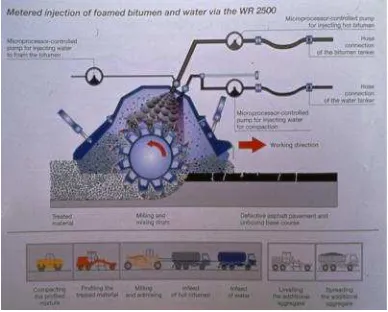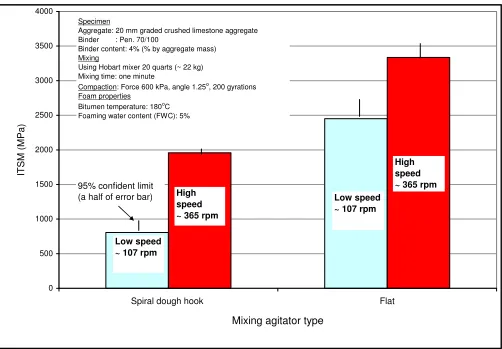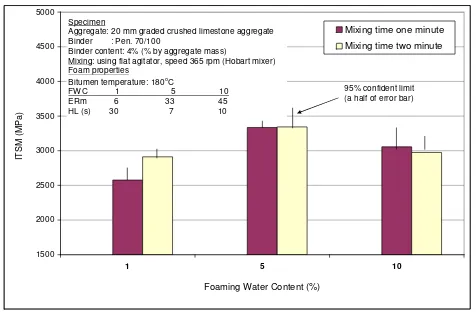Abstract--This paper introduces a sustainable pavement construction using foamed cold mix asphalt (FCMA) technology in order to achieve a better understanding of its road material properties. It is important because the use of cold mix asphalt lags behind hot mix asphalt applications. The methodology used in this paper is by characterisation into FCMA technology based on literature review and experimental studies. The experimental study covers a laboratory investigation of FCMA properties. The closure can be drawn in four issues, i.e. foamed bitumen characteristics, the use of foamed bitumen in road construction, the role of mixing in the process of generating foamed asphalt material, and the considerations for selecting foamed bitumen properties in order to achieve an optimised FCMA.
Keywords: Sustainable construction, pavement, foamed asphalt, foamed bitumen, cold mix, mixing.
I. INTRODUCTION
USTAINABLE pavement constructions using foamed cold mix asphalt (FCMA) become an important issue due to the increase of road infrastructure and its impact on the environment. It is reported that this mixture has been successfully implemented in many roads across the world especially in cold recycling. This mixture has considerable advantages, i.e. conserves aggregates and bitumen, decreases energy usage, minimises waste and reduces fuel consumption & greenhouse gas emission, and the possibility to use a wide variety of aggregates. This mixture also significantly reduces the cost of construction.
This work was supported in part of TPSDP UMS Sub-contract Department of Civil Engineering. S. Sunarjono is researcher of Centre for Transportation Studies, Master of Civil Engineering, Department of Civil Engineering, Universitas Muhammadiyah Surakarta, Jl. A. Yani Pabelan Kartasura Tromol Pos I Surakarta 57102 Telp. (0271) 717417 ext. 159 Fax. (0271) 730772, E-mail:[email protected]
Sri Sunarjono *
Construction using Foamed Cold Mix
Asphalt Technology
Unfortunately, the performance of FCMA is still poorly understood. The overall behaviour during the production process is not well understood. Moreover the foamed bitumen characteristics and their effect on mixture properties are also still unclear. It is noted that addressing the lack of understanding of how the binder works in the mixture is crucial for implementation. FCMA technology generally presents the perception that this type of mixture brings a significant risk due to its complicated behaviour.
As described in Sunarjono et al (2007), if 250g of hot bitumen injected using 2.5g to 25 g of cold water (1-10% of bitumen mass) normally results in foam with a maximum volume around 6 to 42 times that of the bitumen. The ratio between maximum foam volume achieved and the volume of original bitumen is termed the maximum expansion ratio (ERm). The ERm value is mainly dependent upon the amount of water added, namely the foaming water content (FWC). ERm increases with higher FWC. After reaching its maximum volume, the foam dissipates rapidly accompanied by steam gas escaping. The time that the foam takes to collapse to half of its maximum volume is called the half life (HL). In the above example, HL would normally be between 27 to 10 seconds. After a particular time (around 60 seconds), the foam volume reduces very slowly and asymptotically.
Foamed bitumen, as described above, enables the coating of wet aggregates at ambient temperature to form foamed asphalt for road pavement material. This cold-mix asphalt material is an alternative to hot mix asphalt (HMA), a
‘traditional’ mixture of aggregate and bitumen which is mixed at hot
temperature.
As is common for cold-mix asphalts, the strength of FCMA at early life develops with loss of moisture (Sunarjono, 2007). In a pilot scale project (Nunn and Thom, 2002), foamed bitumen bound materials at very early life exhibited stiffness typical of unbound material when their moduli were investigated using a Dynamic Plate tool. Based on Falling Weight Deflectometer (FWD) data, the stiffness at 20oC of the foamed asphalt layer was found to increase from <1000MPa (at early life) to 3500MPa (at one year). The mixture developed to gain satisfactorily high stiffness levels within 6 months.
For a particular mixture, there is an optimum foamed bitumen content
(OFBC) at which the ‘strength’ of the mixture is a maximum. The associated
bitumen content from 1.5% to 3.8% for test carried out under both dry and wet condition. The investigators gave an explanation that variation of moisture content and foam characteristics used can significantly affect the test results. The observed foaming properties (generated using 80/100 bitumen) fluctuated between 6 and 12 seconds for HL and between 15 and 24 for ERm. Unfortunately, the investigators did not report the temperature of the bitumen during the foaming process.
II. OBJECTIVE
The objective of this paper is to introduce a sustainable pavement construction using FCMA technology in order to achieve a better understanding of its road material properties. It is important because the use of cold mix asphalt lags behind hot mix asphalt applications. But, it is quite certain that the use of cold mix asphalt can be improved with a better understanding of material properties and if a much clearer estimate of the material quality can be provided.
III. METHODOLOGY
The methodology used in this paper is by characterization into FCMA technology based on literature review and experimental studies. The literature review is a study on FCMA references based upon previous research results; whereas the experimental study covers a laboratory investigation of FCMA properties. The results from both studies are combined to increase understanding of the essential properties of FCMA as a road pavement material.
IV. MATERIALSUSEDFOREXPERIMENTALSTUDIES
The aggregate used in this study was virgin crushed limestone. Particle gradation as shown in Fig. 1 was designed to be within the ideal grading envelope for foamed asphalt as recommended by Akeroyd and Hicks (1988). The maximum dry density and optimum moisture content were found to be 2.242 Mg/m3 and 6.4% respectively, determined in accordance with BS EN 13286-2: 2004 (modified Proctor).
decreasing temperature.
Fig. 1. Gradation of Virgin Crushed Limestone aggregate
TABLE I
PROPERTIES OFBITUMENPEN50/70, 70/100AND160/220
Property Bitumen Pen
50/70 70/100 160/220
Specific gravity 1.024 1.03 1.021
Penetration (0.1 mm) 54 - 56 85 - 93 180 - 198
Softening Point (oC) 52 - 53 45 - 49 37 - 38
Viscosity at 5oC (kPa.s) 8795 4322 1315
Viscosity at 20oC (kPa.s) 899 257 68
Viscosity at 40oC (kPa.s) 21.90 5.54 1.63
Viscosity at 140oC (mPa.s) 362 262 164
Viscosity at 160oC (mPa.s) 153 114 74
Viscosity at 180oC (mPa.s) 77 57 40
V. RESULTSANDDISCUSSION
A. Foamed Bitumen Characteristics
An understanding of foamed bitumen characteristics is very demanding since the structure of foam-aggregate mixture is not fully defined. The way that foam works in the mixture at every step of construction, namely the mixing process, storage period, compaction, curing period and service live, remains poorly understood.
tends to fall due to gravitational effects. Consequently, a transition is created from wet foam (at the bottom) to dry foam (at the top). In two dimensions (Fig. 2 left), it can be seen that bubble shapes in wet foam are approximately spherical, while in dry foam, the bubbles are more polyhedral.
Fig. 2. An example of a foam in a column frame which forms a transition from wet foam in the bottom to dry foam in the top. (Left) Two dimensional and (right) three dimensional picture (
Schick, 2004)
Quality < 52%
Fig. 4. Effect of FWC on the ERm of foamed bitumen produced using bitumen Pen 70/100 at
Fig. 5. Effect of FWC on the half life of foamed bitumen produced using bitumen Pen 70/100 at varies bitumen temperature.
B. The Use of Foamed Bitumen Technology
Foamed bitumen technology can be usedin road construction either by ‘in -situ (in- place)’ or ‘ex-situ (in-plant)’ method. In neither system is it necessary to heat the aggregate materials (either recycled or fresh aggregates) prior to mixing with foamed bitumen. In-situ treatment offers a cost effective and rapid form of road rehabilitation with relatively lower quality than ex-situ mixing method, whereas ex-situ mixing enables control of input materials and mixing quality and also the material produced can be stored for later use (up to 3 months).
The in-situ process (Fig. 6), consists of recycling a distressed pavement by milling the road to certain depth (100mm to 300mm) using a heavy duty rotovator. This process can be used to recycle distressed asphalt pavement and granular base and/or sub-base layers. The pulverised pavement is then injected with water followed by foamed bitumen sprayed into the recycler’s mixing
Fig. 6. Illustration of the in-situ recycling technology
In the ex-situ mixed process (Fig.7), the plant consists of hoppers for aggregate with a conveyor belt feeding into a pugmill, in which spray bars are fitted for addition of water. Foamed bitumen is sprayed as the wet aggregate drops from the conveyor belt and proceeds to mixing in the pugmill to ensure that foam distribution within the mix is homogenous. The Foamix material then drops onto a conveyor belt where it can be transported to a loading truck or to a stockpile (Maccarone et al, 1995). Currently, progress in the production technology for Foamix has led to the development of mobile mixing plants which can be located close to site in order to reduce the transport cost of materials. The feed materials may be virgin aggregates, road planings, marginal construction materials or combinations of these (Millar and Nothard, 2004). The produced Foamix material appears as moist particles that consists of coated fine aggregate and partly coated coarse aggregate.
Fig. 7. The ex-situ recycling technology
‘semi-bound’ pattern of aggregate-binder structure of FCMA indicates its behaviour is between those of unbound and fully bound materials. As Brown (1994) states, there are three important mechanical properties related to the base course, namely: (1) stiffness, which is to ensure good load spreading ability; (2) fatigue strength, which is to prevent cracking under repeated traffic loading; and (3) resistance to permanent deformation, which is to eliminate rutting. Thus, it is necessary to characterise foamed asphalt in terms of those three fundamental properties for base application.
C. The Role of Mixing Process
The role of mixing in the process of generating foamed asphalt material is important since foamed bitumen collapses rapidly in seconds. Foamed bitumen should be produced at the best quality to ensure that the foam disperses as much as possible in the mixture. Aggregate moisture content should be predetermined properly to ensure foamed bitumen is able to distribute onto the aggregate surface. Mixer capabilities (power, speed and agitator type) should be designed to guarantee the most homogenous foam dispersal in the mixture. During the mixing process, foamed bitumen properties play an important role in helping to produce the optimum end product performance.
Fig. 8 demonstrates the effect of foaming water content (FWC) on the ITSM values for FB 70/100 at 180oC (foamed bitumen produced using bitumen Pen 70/100 at a temperature of 180oC). The specimens were prepared using the flat agitator, in which only aggregates with maximum size of 10mm were mixed with foamed bitumen and aggregate with size of 14mm and 20mm was added later. The optimum performance was obtained with specimens prepared at 5% foaming water, although, as indicated by the 95% confident limit bars, the ITSM values at FWC of 2%-4% and of 6%-10% were no different.
500
Average ITSM value (4 specimens) Average wet (gyratory) density Average dry density 42 - 73 kg/m3
Using 20 mm graded crushed limestone aggregate Using bitumen Pen 70/100
Bitumen temperature 180o C Bitumen content 4% (% by aggregate mass) Mixer agitator: flat type
Compaction: Force 600 kPa, angle 1.25o, 200 gyrations Curing 40o
C-3 days
95% confident limit
Fig.8. Effect of FWC on the ITSM values of well mixed specimens produced using bitumen Pen 70/100
130 140 150 160 170 180 190
Bitumen Temperature (o Using 20 mm graded crushed limestone aggregate Bitumen content 4% (% by aggregate mass) Mixer agitator: flat type
Compaction: Force 600 kPa, angle 1.25o, 200 gyrations Curing 40o
C-3 days
95% Confident limit
Fig. 9. Effect of bitumen temperature on the ITSM values for specimens produced using bitumen Pen 50/70, Pen 70/100 and Pen 160/220.
the main factor affecting lack of stiffness at early age.
Low moisture content causes inadequate foam dispersal in the mix, whereas too much water will significantly reduce the strength and extend the curing time. Therefore, moisture content should be close to the optimum moisture content for compaction. The moisture needed is dependent on compaction level used - the higher the level the lower the moisture, and filler content (Maccarone et al, 1994). The aggregate moisture content may influence the bitumen content used in the mixture. Brennen et al (1983) found that if the amount of aggregate moisture decreases the bitumen content should increase.
Several versions of moisture content determination method have been proposed as following.
Fluff point method. The Fluff point, developed by Mobil Oil, is the
moisture content at which the aggregate has a maximum loose bulk volume. Brennen et al (1983) found that this point is close to 70-80% modified Proctor optimum moisture content (OMC).
Water application at 65-85 % of the modified Proctor OMC (Lee, 1981 and confirmed by Bissada, 1987).
Total fluid content concept. This concept is borrowed from emulsion
mixture design in which the sum of the water and bitumen content should be close to OMC. Castedo-Franco and Wood (1983) agreed with this concept.
Sakr and Manke (1985) concept. This concept uses mixing moisture
content (MMC), depending on the modified Proctor OMC, percentage of fines (PF) in the aggregate and the bitumen content (BC) as described in Eq. 1.
MMC =8.92+1.48 OMC+0.4 PF-0.39BC …...Eq. 1
High moisture content method. Jenkins et al (2002) applied this
method. Because low moisture content produces a poor quality mix, therefore the moisture content was set at a high level (around 1-2 % higher than OMC). After the mixing process the material was air dried for 30 minutes to achieve the optimum fluid content (OFC) necessary for compaction.
Wirtgen concept. This method uses optimum compaction and
workability content (OCC) which is equal OMC reduced by a reduction water content (WCreduc) that depends upon that OMC value (Eq.2).
OCC = OMC–WCreduc. ...Eq. 2 Where, WCreduc. = 0 (for OMC less than 2%)
Fig. 10 demonstrates the effect of mixing speed on the cured specimen stiffness measured at 20oC. Two mixing speeds have been investigated i.e. 107 rpm (termed low speed) and 365 rpm (termed high speed). It can be seen that mixing speed has a significant effect on mixture stiffness for both mixer-agitator types. The higher mixing speed results in higher mixture stiffness.
Fig.10 also shows the effect of mixer-agitator type used in the mixing process on mixture stiffness. In this case, the specimens produced using a flat agitator type resulted in higher mixture stiffness than with a spiral dough hook type, for both mixing speeds. The spiral dough hook agitator having a single spiral rod performs less well than the flat type which has a wide frame. The wide frame causes all particles to agitate simultaneously and allows the binder to distribute effectively across the aggregate surface.
All specimens shown in Fig.10 were mixed for one minute after foam spraying, whereas Fig.11 presents a comparison of mixture stiffnesses between specimens mixed for one minute and two minutes. Three types of specimen, i.e. produced at FWC of 1%, 5% and 10%, have been investigated, representing different foam properties in terms of ERm and HL characteristics. It can be seen that mixing time has a moderate effect on the mixture stiffness of specimens produced at FWC 1%, but not at FWC 5% and
10%. Mixing time appears more related to the foam’s half life rather than its
expansion. A foam with longer half life has a better chance of improving its
Aggregate: 20 mm graded crushed limestone aggregate Binder : Pen. 70/100
Binder content: 4% (% by aggregate mass) Mixing
Using Hobart mixer 20 quarts (~ 22 kg) Mixing time: one minute
Compaction: Force 600 kPa, angle 1.25o, 200 gyrations
Foam properties Bitumen temperature: 180oC
Foaming water content (FWC): 5%
95% confident limit (a half of error bar)
1500
Aggregate: 20 mm graded crushed limestone aggregate Binder : Pen. 70/100
Binder content: 4% (% by aggregate mass) Mixing: using flat agitator, speed 365 rpm (Hobart mixer) Foam properties
Fig.11. Effect of mixing time on the mixture stiffness at different foam properties
D. Strategy to Achieve an Optimised FCMA
The parameters considered to achieve an optimised FCMA are (a) mixing protocol, (b) binder type, and (c) maximum expansion ratio (ERm). These parameters are considered since they are easily measured/ defined and controlled during foam production. FWC and bitumen temperature are found to be main parameters in affecting foam viscosity, whereas foam viscosity and ERm combine to influence the FCMA stiffness.
Mixing protocol is found to be a major parameter affecting FCMA performance. If a FCMA has been designed properly but is not mixed using a good mixer, it can not be guaranteed to produce a uniform binder distribution. Three aspects have been identified that affect the mixing performance, i.e. mixing speed, agitator type and mixing time. The two principles governing mixer suitability for FCMA are (firstly) that the mixing speed should be fast enough to cope with the rate of foam spraying, enabling aggregate particles to distribute as thoroughly as possible while the binder is still workable, and (secondly) that the mixer agitator should enable as much aggregate agitation as possible to expose aggregate surfaces to foam spraying and to cut the binder-fine particles into suitably small size.
foam is a less significant factor in its effect on binder distribution.
In the field (in in-situ cases), mixer power and capacity and depth of pavement to be recycled are of prime importance in producing a more homogenous binder distribution in the mixture. Clearly, a shallow depth of recycled pavement will reduce the required mixer power, and hence it is suggested that when using low bitumen pen and a thick recycled layer, the mixer power and capacity should be as high as possible. If the mixer power and capacity is limited, it is better to use a higher bitumen pen, thinner pavement layer, and possibly, lower ERm (in the range of stable values).
The considerations in selecting binder type for FAM are basically similar to those for common bituminous materials, namely traffic load type (heavy or light traffic) and regional climate, for which a heavily trafficked road or a road in a hot region requires a harder binder. However, in FAM, binder type also significantly affects the distribution of binder-fines particles during the mixing process, which influences the mixture stiffness. Thus, the effect of binder type on binder distribution should be combined with its effect on mixture performance when considering binder type selection for FAM.
Binder type influences viscosity and stiffness modulus. Low bitumen pen will normally have high viscosity and high stiffness modulus. Thus, a FAM using low bitumen pen will be negatively affected during mixing since binder with high viscosity reduces workability, but there will be a positive effect on mixture stiffness due to the high stiffness of the bitumen. For a FAM using high bitumen pen, the situation will be reversed. Thus, when selecting binder type for FAM material two things should be considered, i.e. mixer capability and regional climate. A FAM using low bitumen pen should be mixed using a high speed mixer to ensure good binder distribution; if a suitable mixer is not available, it is better to use a higher bitumen pen. On the other hand, if a FAM is to be paved in a cold region, a softer binder will be better since binder distribution is more important in developing mixture stiffness at low temperature; however in a hot region, a harder binder is more suitable since binder modulus is more important in developing mixture stiffness at high temperature.
Following the above description, the limits of the ERm zones that give good mixture performance can be estimated from the ranges of foam quality. Two limit points can be identified, i.e. (1) Minimum ERm value to produce an effective mixture, and (2) Minimum ERm value to produce a stable mixture performance.
The first minimum ERm value means that foamed bitumen starts to be able to mix effectively with cold wet aggregate, although the resulting mixture may not have stable performance. If the ERm is less than this value, the resulting mixture will be uncombined asphalt, as when hot bitumen is sprayed onto wet aggregate. This limit is estimated to represent the start of wet foam structure, i.e. at a gas content of around 52% which is equal to an ERm of around 2-3. This value should probably be increased to 5 to give a suitable safety factor for practical purposes. It is therefore recommended that a minimum ERm value of 5 (80% gas content) is used to produce an effective FAM. This value is normally close to that of a foamed bitumen produced at FWC of 1%, depending on binder type and bitumen temperature.
The second limit represents the minimum value of ERm at which foamed bitumen can distribute uniformly onto wet aggregate and hence it results in an optimum mixture performance. This limit is estimated to be at the start of the stable dry foam region, i.e. at a gas content of around 87.5%, which is equal to a ERm of about 8. Applying a safety factor, this study recommends an ERm value of 10 (gas content of 90%) as a minimum. It should be understood that this value may not be exact due to differences in mixing effectiveness. As an example, a foam with ERm of 10 may produce optimum mixture performance when thorough mixing is applied (e.g. good mixer, low batching mass or small maximum aggregate size); however if poorer mixing is applied, it is possible that use of an ERm of 8, for example, may produce a similar or even better mixing performance. This value (ERm of 10) can normally be obtained from a foamed bitumen produced at FWC less than 2% (typically around 1.5%), depending on binder type and bitumen temperature.
VI. CLOSURE
Foamed bitumen technology can be usedin road construction either by ‘in -situ (in- place)’ or ‘ex-situ (in-plant)’ method. In neither system is it necessary to heat the aggregate materials (either recycled or fresh aggregates) prior to mixing with foamed bitumen. In-situ treatment offers a cost effective and rapid form of road rehabilitation with relatively lower quality than ex-situ mixing method, whereas ex-situ mixing enables control of input materials and mixing quality and also the material produced can be stored for later use (up to 3 months).
The role of mixing in the process of generating foamed asphalt material is important since foamed bitumen collapses rapidly in seconds. Foamed bitumen should be produced at the best quality to ensure that the foam disperses as much as possible in the mixture. Aggregate moisture content should be predetermined properly to ensure foamed bitumen is able to distribute onto the aggregate surface. Mixer capabilities (power, speed and agitator type) should be designed to guarantee the most homogenous foam dispersal in the mixture.
The parameters considered to select foamed bitumen properties in order to achieve an optimised FCMA are (a) mixing protocol, (b) binder type, (c) maximum expansion ratio (ERm) and (d) foaming water content (FWC) and bitumen temperature.
VII. ACKNOWLEDGMENT
The author would like to express his thanks to Dr. N.H. Thom, Dr. S.E. Zoorob, and Assoc. Prof. A. R. Dawson for their excellent supervision, guidance, support and encouragement throughout the course of this study.
VIII. REFERENCES
F.M.L. Akeroyd,and B.J.Hicks. "Foamed Bitumen Road Recycling, "Highways, Volume 56, Number1933, pp 42, 43, 45.
A.F. Bissada, "Structural Response of Foamed-Asphalt-Sand Mixtures in Hot Environments, " In: Asphalt materials and mixtures. Washington, DC: Transportation Research Board.
(Transportation Research Record, 1115), pp 134-149. 1987.
M. Brennen, M. Tia, A.G. Altschaeffl, and L.E. Wood, "Laboratory Investigation of The Use of Foamed Asphalt for Recycled Bituminous Pavements, " In: Asphalt materials, mixtures, construction, moisture effects and sulfur. Washington, DC: Transportation Research
Board. (Transportation Research Record; 911), pp 80-87. 1983.
C.J.W. Breward, "The Mathematics of Foam,"PhD Thesis, St. Anne’s College, University of
S.F. Brown, Properties of Road Layers, In: Bituminuous mixtures in road construction, pp 43-63. Edited by Hunter, R.N. Thomas Telford, London, 1994.
L.H. Castedo-Franco and L.E. Wood, "Stabilisation with Foamed Asphalt of Aggregate Commonly Used in Low Volume Road, " In: Low volume road: 3rd International Conference. Washington, DC: Transportation Research Board. Transportation Research
Record: 898, pp 297-302, 1983.
K.J. Jenkins, A.A.A. Molenaar, J.L.A. de Groot, M.F.C. van de Ven, "Foamed Asphalt Produced Using Warmed Aggregates," The Association of Asphalt Paving Technologists, 2002.
K.J. Jenkins, S. Robroch, M.G. Henderson, J. Wilkinson, and A.A.A. Molenaar. "Advanced Testing for Cold Recycling Treatment Selection on N7 Near Cape Town, " in Proc. of the 8thConference on Asphalt Pavements for Southern Africa (CAPSA ’04), ISBN Number: 1 -920-01718-6, paper 079, 12-19 September 2004, Sun City, South Africa.
A.M. Kraynik, "Foam Drainage," Sandia Report, Sand 83-0844, Prepared by Sandia National Laboratories, Albuquerque, New Mexico 87185 and Livermore, California 94550 for the United States Department of Energy under Contract DE-AC04-76DP00789, 1983.
D.Y. Lee, "Treating Marginal Aggregates and Soil with Foamed Asphalt," In: Proceedings of the Association of Asphalt Paving Technologists, Vol. 50, pp 211-150. 1981.
S. Maccarone, G. Holleran, D.J. Leonard, and S. Hey, "Pavement Recycling Using Foamed Bitumen," in Proceeding 17thARRB Conference, Part 3, 1994.
S. Maccarone, G. Holleran, and A. Ky, "Cold Asphalt System as an Alternative to Hot Mix," in Proc. 9thAAPA International Asphalt Conference, 1995.
D. Miller and B. Nothard, "The Blending of Marginal Materials Using Foamed Bitumen," in Proceedings of the 8thConference on Asphalt Pavements for Southern Africa (CAPSA ’04),
ISBN Number: 1-920-01718-6, 12-16 September 2004, Sun City, South Africa, 2004.
A. Nataatmaja. "Some Foamed Bitumen Mix: Soil or Asphalt?, "In Proc. 2002, 9thInternational Conference on Asphalt Pavements, pp. 14-21.
M. E. Nunn, and N.H. Thom, "Foamix: Pilot Scale Trials and Design Considerations," Viridis Report VR1, First Published ISSN 1478-0143, Copyright TRL Limited, 2002.
M.D. Rankin, T.J. Friesenhahn, W.R. Price and C. Pool, Lightened Fluid Hydraulics and
Inclined Boreholes, SPE/IADC 18670, New Orleans, 1989.
H.A. Sakr and P.G. Manke, "Innovations in Oklahoma Foamix Design Procedures, " In: Asphalt materials, mixes, construction and quality. Washingtong, DC: Transportation Research
Board. (Transportation Research Record;1034), pp 26-34. 1985.
L.L Schramm. "Foams: Fundamentals and Applications in the Petroleum Industry, " Advances in
Chemistry series 242, American Chemical Society, Washington DC, 1994.
B. Shackel, K. Makhiuchi, and J.R. Derbyshire. "The Response of a Foamed Bitumen Stabilised Soil to Repeated Triaxial Loading, " in Proc. 1974 ARRB, Paper No A23, Volume 7, Part
7, 1974, 74-87.
S. Sunarjono, N.H. Thom, and S.E. Zoorob. "Influence of Foaming Water on the Foaming Process and Resultant Asphalt Mix Stiffness," in Proc. 2007 4th International SIIV
Congress, Palermo,Italy, September 12-14.
D. Weaire, N. Pittet, S. Hutzler, and D. Pardal. "Steady-State Drainage of an Aqueous Foam, "
Physical review letters, volume 71, Number 16, The American Physical Society, 1993.
Wirtgen, Cold Recycling Manual, 2ndedition. ISBN 3-936215-05-7, Wirtgen GmbH, Hohner Strasse 2.53578 Windhagen, Germany, 2004.
IX. BIOGRAPHIES
Sri Sunarjono was born in Salatiga, Indonesia, on
